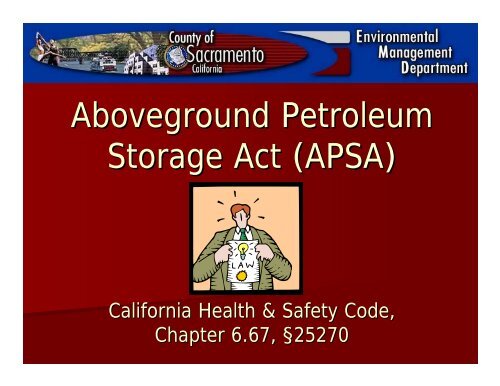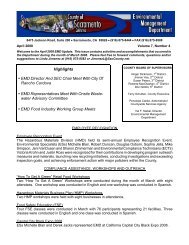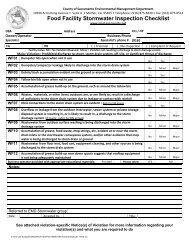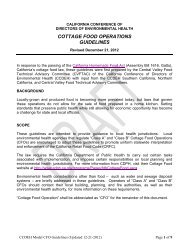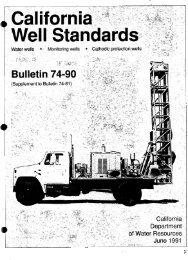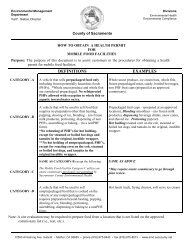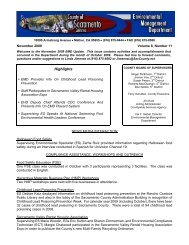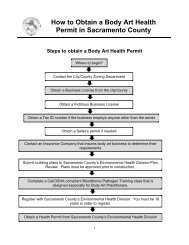APSA - Environmental Management Department, Sacramento County
APSA - Environmental Management Department, Sacramento County
APSA - Environmental Management Department, Sacramento County
You also want an ePaper? Increase the reach of your titles
YUMPU automatically turns print PDFs into web optimized ePapers that Google loves.
Aboveground Petroleum<br />
Storage Act (<strong>APSA</strong>)<br />
California Health & Safety Code,<br />
Chapter 6.67, §25270
Presentation Overview<br />
•<strong>APSA</strong> Provisions<br />
•Applicability<br />
•Exemptions<br />
•Requirements of <strong>APSA</strong><br />
•Definitions<br />
•SPCC Rule Overview<br />
•Types of Facilities<br />
•Compliance Dates<br />
•What Does This Mean<br />
For You<br />
•Fees<br />
•Additional Information
Major <strong>APSA</strong> Provisions<br />
• Establishes the California Aboveground<br />
Petroleum Storage Act (<strong>APSA</strong>) – passed October<br />
2007, became effective on January 1, 2008.<br />
• Provides definitions for AST, petroleum, storage<br />
capacity, etc.<br />
• Defines applicability and exemptions for tank<br />
facilities.
Major <strong>APSA</strong> Provisions<br />
• Transfers the authority and responsibility of the<br />
<strong>APSA</strong> from the SWRCB and RWQCB to the<br />
CUPAs.<br />
• Requires owner/operator of a regulated tank<br />
facility to prepare and implement a Spill<br />
Prevention Control & Countermeasure (SPCC)<br />
Plan.<br />
• Requires the CUPAs to conduct inspections at<br />
regulated tank facilities with an aggregate<br />
storage capacity ≥10,000 gallons of petroleum at<br />
least every 3 years.
Major <strong>APSA</strong> Provisions<br />
• Requires the CUPA inspectors to obtain<br />
training/certification.<br />
• Establishes civil penalties<br />
–
Who is Subject to <strong>APSA</strong><br />
• A tank facility is subject to <strong>APSA</strong> if:<br />
– The tank(s) ) contain petroleum.<br />
– The tank facility has a storage capacity of<br />
1,320 gallons or more of petroleum.
Who is Exempt<br />
• Farms, nurseries, logging and construction sites<br />
are NOT required to prepare and implement an<br />
SPCC Plan IF:<br />
– No storage tank exceeds 20,000 gallons<br />
AND<br />
– The cumulative storage capacity does not<br />
exceed 100,000 gallons.
Who is Exempt<br />
• Exempt facilities are still regulated under <strong>APSA</strong><br />
and required to:<br />
– Submit a Tank Facility Statement.<br />
– Submit fees annually.<br />
– Conduct daily visual inspections.<br />
– Allow the CUPA to conduct periodic<br />
inspections.
What is Excluded<br />
• Most oil-filled electrical equipment (transformers,<br />
circuit breakers, capacitors, etc.) are excluded:<br />
– 10,000 gallons of dielectric fluid per piece of<br />
equipment:<br />
• PCB concentration
Requirements of <strong>APSA</strong><br />
• SPCC Plan<br />
– Prepare an SPCC Plan in accordance with U.S.<br />
Code of Federal Regulations Title 40, Part 112<br />
(40CFR112).<br />
– Conduct periodic self inspections (inspections,<br />
tests, and records).<br />
– Implement SPCC Plan in compliance with<br />
40CFR112.
Requirements of <strong>APSA</strong><br />
• Tank Facility Statement<br />
– Annual submittal of a tank facility statement<br />
– Form available online – www.emd.saccounty.net
Requirements of <strong>APSA</strong><br />
• Spill Reporting<br />
– Owner/operator of tank facility.<br />
– Immediately report, upon discovery.<br />
– 42 gallons or more of petroleum.<br />
– Governor’s s Office of Emergency Services (OES) and<br />
the CUPA.
What is an AST<br />
• “…a a tank that has the capacity to store 55<br />
gallons or more of petroleum and that is<br />
substantially or totally above the surface of the<br />
ground” (HSC 25270.2(a)).
What is Petroleum<br />
• Crude oil (or a fraction thereof);<br />
• Liquid state at 60°F;<br />
• Normal atmospheric pressure at sea level (14.7<br />
pounds per square inch).
•Examples include:<br />
– Petroleum-based fuels<br />
(automotive, heating, etc.)<br />
What is Petroleum<br />
– Biofuels if they contain any<br />
percentage of petroleum<br />
(E85, B20, etc.)<br />
– Gasoline<br />
– Petroleum-based<br />
lubricating oils and<br />
greases (including waste<br />
oils)<br />
– Oil-based paints,<br />
coatings, thinners and<br />
solvents<br />
– Petroleum distillates<br />
– Petroleum- or petroleum-<br />
based additives<br />
(including ink, paint, etc.<br />
additives)<br />
– Petroleum solvents<br />
– Crude oil
What isn’t t Petroleum<br />
Fuels which are not liquid at 60°F F at normal<br />
atmospheric pressure are not considered<br />
“petroleum” under <strong>APSA</strong>.<br />
Examples include:<br />
• Propane<br />
• Liquid Natural Gas
What isn’t t Petroleum<br />
100% vegetable or plant-based fuels unless<br />
the fuel or liquid contains ANY concentration<br />
of petroleum.<br />
Examples include:<br />
• B100 biodiesel<br />
• Corn ethanol
What is a tank facility<br />
• Any one, or combination of,<br />
aboveground storage tanks,<br />
including piping that is<br />
integral to the tank;<br />
• Contains petroleum;<br />
• Used by a single business<br />
entity at a single location or<br />
site.
SPCC Rule Overview<br />
• Code of Federal Regulations, Title 40 Part 112<br />
• Requirements help prevent oil discharges to<br />
navigable waters or adjoining shorelines.<br />
• SPCC Plan should describe equipment,<br />
workforce, procedures, and training to prevent,<br />
control, and provide adequate countermeasures<br />
to a discharge of oil.
Types of Facilities<br />
• Qualified<br />
– Tier I<br />
– Tier II<br />
• Non-qualified (all other facilities)
Tier I<br />
Qualified Facilities<br />
Tier II<br />
•≤10,000 gallon aggregate aboveground oil storage capacity; and<br />
•Within any twelve-month period, three years prior to the Plan certification date, or since<br />
becoming subject to the SPCC rule if in operation for less than three years, there has<br />
been: (1) No single discharge of oil to navigable waters or adjoining shorelines exceeding<br />
1,000 U.S. gallons; and (2) No two discharges of oil to navigable e waters or adjoining<br />
shorelines each exceeding 42 U.S. gallons; and<br />
•No individual aboveground oil<br />
containers greater<br />
than 5,000 U.S. gallons;<br />
•Then: Complete and self-certify Plan<br />
template (Appendix G to 40 CFR part<br />
112) in lieu of a full PE-certified Plan.<br />
•Has individual aboveground oil containers<br />
greater than 5,000 U.S. gallons; or Owner or<br />
operator eligible for Tier I qualified facility<br />
status, but decides not to take the option or<br />
chooses to develop a ‘‘hybrid<br />
hybrid’’<br />
Plan;<br />
•Then: Prepare self-certified Plan in accordance<br />
with all applicable requirements of § 112.7 and<br />
subparts B and C of the rule, in lieu of a PE-<br />
certified Plan.
Non-Qualified (All Other Facilities)<br />
• More than 10,000 U.S. gallons aggregate aboveground oil storage capacity, or<br />
• Within any twelve-month period, three years prior to the Plan certification date, or<br />
since becoming subject to the SPCC rule if in operation for less than three years,<br />
there has been:<br />
(1) A single discharge of oil to navigable waters or adjoining shorelines s<br />
exceeding<br />
1,000 U.S. gallons; or<br />
(2) Two discharges of oil to navigable waters or adjoining shorelines each exceeding 42<br />
U.S. gallons; or<br />
• Owner or operator eligible for qualified facility status, but decides not to take the<br />
option<br />
• Then: Prepare PE-certified Plan in accordance with all applicable requirements of<br />
§ 112.7 and subparts B and C.
Compliance Dates<br />
A facility starting operation…<br />
Must…<br />
On or before August 16, 2002<br />
After August 16, 2002 through<br />
November 10, 2010<br />
After November 10, 2010<br />
• Maintain its existing SPCC Plan<br />
• Amend and implement the<br />
SPCC Plan no later than<br />
November 10, 2010.<br />
• Prepare and implement the<br />
SPCC Plan no later than<br />
November 10, 2010.<br />
• Prepare and implement a SPCC<br />
Plan before beginning<br />
operations.
What Does This Mean for You<br />
• Prepare an SPCC Plan in accordance 40CFR112.<br />
• Conduct periodic inspections (inspections, test,<br />
and records).<br />
• Implement the SPCC Plan.
What Does This Mean for You<br />
• CUPA inspection at least once every three years<br />
tank facilities that have a storage capacity of<br />
10,000 gallons or more of petroleum.<br />
• The purpose of the inspection is to determine<br />
whether the owner/operator is in compliance<br />
with the SPCC Plan Requirements of <strong>APSA</strong>.
What Does This Mean for You<br />
• Facilities ≥10,000 gallons<br />
– Submit a Tank Facility Statement annually.<br />
• Facilities
Potential <strong>APSA</strong> Violations<br />
• Failure to prepare and implement an SPCC Plan<br />
• Failure to file a tank facility statement<br />
• Failure to submit required annual fee (beginning<br />
2010)<br />
• Violations subject to fines & penalties
Fees<br />
• Each year, commencing in calendar year 2010,<br />
each owner/operator of a tank facility subject to<br />
the requirements of subdivision 25270.6(a) shall<br />
pay a fee to the CUPA, on or before a date<br />
specified by the CUPA.<br />
• EMD will conduct fee workshops in the near<br />
future.
Contact Information<br />
<strong>Environmental</strong> <strong>Management</strong> <strong>Department</strong><br />
Phone: (916) 875-8550<br />
8550<br />
Supervisor – Anthony Chu<br />
(916) 875-8405<br />
8405<br />
EMD Website: www.emd.saccounty.net


